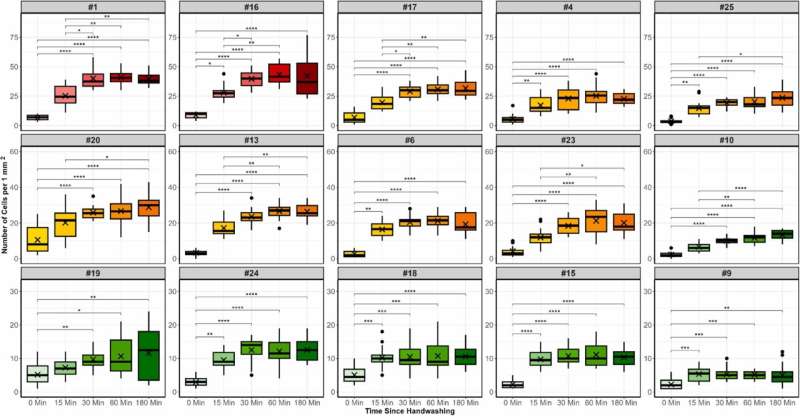This article has been reviewed according to Science X's editorial process and policies. Editors have highlighted the following attributes while ensuring the content's credibility:
fact-checked
trusted source
proofread
New forensics technique measures individual DNA shedding to aid criminal investigations

A pioneering new DNA forensics technique is looking for a reliable method to measure a suspect's individual level of natural shedding of skin and other cells to add to, and compare with, evidence collected at crime scenes.
Using a novel technique of cell staining developed at Flinders University, forensic science experts have tested 100 people to confirm how people shed varying levels of touch DNA, from very low to very high.
The article, "Shedding more light on shedders," has been published in Forensic Science International: Genetics.
"Our latest study also shows that males are more prolific at shedding in general, depositing more cells per square millimeter than females," says Professor Adrian Linacre, from the College of Science and Engineering.
"Also, there was no difference in the deposition of cells between right and left thumbs, so it doesn't matter if an item is held in someone's right or left hand."
The study stems from a pilot study three years ago, and aims to develop a new avenue to track down criminals—including evidence from people who might be "poor shedders."
Professor Linacre says suspects implicated by DNA in a criminal act might one day raise the defense: "But I am a high shedder."
Of 100 donors in the study, 98 gave consistent and reproducible cell number deposition—showing people shed the same cells "no matter when" samples are taken.
The new study makes progress to develop a robust, simple and affordable test of a suspected perpetrators' "shedder status" as an additional means of DNA profiling and testing the possible time spent at a crime scene. This potentially could be a way to reduce investigation timeframes, and reduce the possibility of conflicting DNA evidence.
"Depending on what type of 'shedder' a person is, confirmation of their shedder status can guide investigators as to the propensity of an individual to pass on their DNA to an item via touch contact with the hand.
"This information can be used in a likelihood ratio to evaluate the probability of finding a person's DNA on an item," Professor Linacre explains.
Researchers stress more needs to be done to find the best way to assess shedder status.
More information: Piyamas Petcharoen et al, Shedding more light on shedders, Forensic Science International: Genetics (2024). DOI: 10.1016/j.fsigen.2024.103065
Provided by Flinders University





















